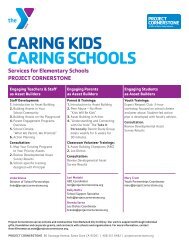Camp Campbell Outdoor Science School Teacher & Parent ...
Camp Campbell Outdoor Science School Teacher & Parent ...
Camp Campbell Outdoor Science School Teacher & Parent ...
You also want an ePaper? Increase the reach of your titles
YUMPU automatically turns print PDFs into web optimized ePapers that Google loves.
CCS 6 th -Earth <strong>Science</strong> 2.d Students know earthquakes, volcanic eruptions, landslides, and floods change human and wildlifehabitats.ESS2.B- The locations of mountain ranges, deep ocean trenches, ocean floor structures, earthquakes, andvolcanoes occur in patterns. Most earthquakes and volcanoes occur in bands that are oft en alongboundaries between continents and oceans. Major mountain chains form the inside continents ornear their edges. Maps can help locate the different land and water features where people live andin other areas of Earth.CCS 6 th -Earth <strong>Science</strong> 1.a Students know evidence of plate tectonics is derived from the fit of the continents; the location ofearthquakes, volcanos, and midocean ridges; and the distribution of fossils, rock types, and ancientclimatic zones.CCS 6 th -Earth <strong>Science</strong> 1.b Students know Earth is composed of several layers: a cold, brittle lithosphere; a hot, convectingmantle; and a dense, metallic core.CCS 6 th -Earth <strong>Science</strong> 1.c Students know lithospheric plates the size of continents and oceans move at rates of centimetersper year in response to movements in the mantle.CCS 6 th -Earth <strong>Science</strong> 1.d Students know that earthquakes are sudden motions along breaks in the crust called faults andthat volcanoes and fissures are locations where magma reaches the surface.CCS 6 th -Earth <strong>Science</strong> 1.e Students know major geologic events, such as earthquakes, volcanic eruptions, and mountainbuilding, result from plate motions.CCS 6 th -Earth <strong>Science</strong> 1.f Students know how to explain major features of California geology (including mountain, faults, andvolcanos) in terms of plate tectonics.CCS 6 th -Earth <strong>Science</strong> 1.g Students know how to determine the epicenter of an earthquake and know that the effect of anearthquake on any region vary, depending on the size of the earthquake, the distance of the regio nfrom the epicenter, the local geology, and the type of construction in the region.ESS2.C- Water is found almost everywhere on Earth: as vapor; as fog clouds in the atmosphere; as rain orsnow falling from clouds; as ice, snow and running water on land and in the ocean; and asgroundwater beneath the surface. The downhill movement of water as it flows to the ocean shapesthe appearance of the land. Nearly all of the Earth’s available water is in the ocean. Most freshwater is in glaciers or underground; only a tiny fraction is in the streams, lakes, wetlands, and theatmosphere.CSS 5 th -Earth <strong>Science</strong> 3.a Students know most of the Earth’s water is present as salt water in the oceans, which cover mostof the Earth’s surface.CSS 5 th -Earth <strong>Science</strong> 3.b Students know when liquid water evaporates, it turns into water vapor in the air and can reappearas a liquid when cooled or as solid if cooled below the freezing point of water.CSS 5 th -Earth <strong>Science</strong> 3.c Students know water vapor in the air moves from one place to another and can form fog or clouds,which are tiny droplets of water or ice, and can fall to Earth as rain, hail, or snow.CSS 5 th - Earth <strong>Science</strong> 3.d Students know that the amount of fresh water located in rivers, lakes, underground sources, andglaciers is limited and that its availability can be extended by recycling and decreasing the use ofwater.CCS 5 th -Earth <strong>Science</strong> 3.e Students know the origin of the water used by their local communities.ESS2.D- Weather is the minute-by-minute to day-by-day variation of the atmosphere’s condition on a localscale. Scientists record the patterns of the weather across different times and areas so that theycan make predictions about what kinds of weather might happen next. Climate describes the26





